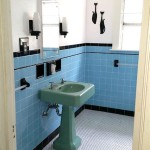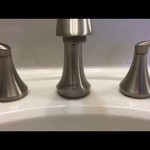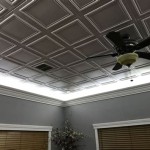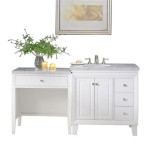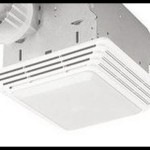How To Turn a Dresser Into a Bathroom Vanity
Repurposing a dresser into a bathroom vanity offers a unique way to add character and personalize a bathroom space. This project can also be a cost-effective alternative to purchasing a new vanity. Successfully transforming a dresser involves careful planning and execution. This guide outlines the key steps required for this conversion.
Assessment and Preparation: Begin by carefully assessing the dresser's dimensions to ensure it fits comfortably within the bathroom and allows adequate space for movement. Measure the height, width, and depth, considering existing plumbing locations and door clearances. Evaluate the dresser's structural integrity. A solid, well-built dresser is essential for supporting the weight of a sink and countertop.
Plumbing Considerations: Determine the location of the existing plumbing and whether modifications are necessary. If the dresser's placement requires altering the plumbing, consult a qualified plumber. This professional guidance ensures the work adheres to building codes and prevents future issues. Measure the distance between the hot and cold water supply lines and the drainpipe to ensure compatibility with the chosen sink.
Selecting a Sink and Countertop: Choose a sink that complements the dresser's style and size. Common options include vessel sinks, undermount sinks, and drop-in sinks. Each sink type requires specific modifications to the dresser top. Consider the countertop material carefully. Options range from natural stone like granite or marble to engineered materials like quartz or solid surface. Measure the dresser top accurately to determine the required countertop dimensions.
Modifying the Dresser: Prepare the dresser by removing the existing top. Depending on the dresser's construction, this may involve unscrewing it or carefully prying it off. Reinforce the dresser's frame if necessary, especially if the dresser is older or made of a lighter material. This added support will help prevent sagging under the weight of the sink and countertop. Cut an opening in the dresser top to accommodate the chosen sink. Use a jigsaw or other appropriate cutting tool. Follow the manufacturer's instructions for the specific sink type regarding the size and shape of the opening.
Installing the Sink and Countertop: Install the chosen sink according to the manufacturer’s instructions. This may involve applying sealant, securing clips, or other specific mounting methods. Place the countertop on the dresser, ensuring proper alignment. Secure the countertop using appropriate fasteners, such as screws or adhesive, depending on the countertop material and the dresser's construction.
Plumbing Connections: Connect the plumbing to the sink, ensuring tight seals to prevent leaks. If modifications to the plumbing are necessary, it's recommended to hire a qualified plumber. Test all connections thoroughly for leaks after installation. This crucial step can prevent water damage and ensure the vanity's longevity.
Finishing Touches: Apply a waterproof sealant to protect the dresser from moisture damage. This is particularly important for areas around the sink and countertop. Consider adding a backsplash to further protect the wall from water splashes. Backsplashes also enhance the vanity's aesthetic appeal. Install hardware, such as drawer pulls and knobs, that complement the bathroom's decor. Consider repainting or refinishing the dresser to match the bathroom's color scheme. This provides a cohesive and polished final look.
Ventilation: Adequate ventilation is critical in any bathroom to prevent moisture buildup and potential mold growth. If the dresser previously had drawers where the plumbing now resides, ensure that there is sufficient ventilation around the pipes. Consider installing a small vent or leaving a strategically placed access panel to allow for airflow. This helps maintain a dry environment and prevents potential plumbing issues.
Maintenance: Regular maintenance is essential to preserve the converted vanity. Wipe up spills promptly to prevent water damage. Regularly inspect the plumbing for leaks and address any issues immediately. Reapply waterproof sealant as needed to maintain protection against moisture. These preventative measures will extend the life of the vanity and maintain its attractive appearance.
Safety Considerations: Always turn off the water supply before beginning any plumbing work. Use appropriate safety equipment, such as eye protection and gloves, when working with tools and materials. Dispose of old plumbing fixtures and construction debris properly according to local regulations. If any electrical work is involved, such as installing lighting fixtures, consult a qualified electrician. Prioritizing safety throughout the project is crucial for a successful and hazard-free outcome.

How To Make A Dresser Into Vanity Tutorial An Oregon Cottage

A Pro Renovator S 6 Tips For Turning Dresser Into Bathroom Vanity

Turn A Vintage Dresser Into Bathroom Vanity

Repurposed Dresser Converted To Bathroom Vanity Reinvented Delaware

Flipping Houses Home Renovation In Silicon Valley

Mid Century Dresser Into Vanity Bright Green Door

Stunning Bathroom Tour Dresser Into Double Vanity

How To Convert A Dresser Into Bathroom Vanity The Little By Home

Repurposed Dresser Converted To Bathroom Vanity Reinvented Delaware
/103058794-9279662b921c41259cb908f3cb19acd9.jpg?strip=all)
How To Turn An Old Dresser Into A Beautiful Bathroom Vanity
Related Posts

